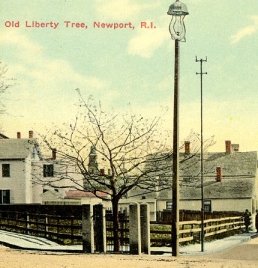Almost 240 years ago William Read donated a small triangular plot
of land at Thames and Farewell streets to William Ellery and other
Sons of Liberty, shortly after the successful struggle to force the
British Parliament to repeal the Stamp Act.
The donation was welcomed not for the land, but for the tall
buttonwood tree, known as "The Liberty Tree," that stood on the
property.

Sometime in 1765, the Sons of Liberty began rallying at the tree
to protest the hated Stamp Act that the colonists believed was
unjust taxation and the latest case of oppression by Parliament.
Andrews said the nearby Common Burying Ground was a backdrop for
mock funerals the protesters held for "Liberty." The group also
hung in effigy people who defended the British policies.
The Liberty Tree remained a gathering point during the decade
leading up to the Revolutionary War, Andrews said. The local tree
became such an icon for the independence movement that Gen. Thomas
Gage ordered it be cut down some time after the British occupied
Newport in December 1776, Andrews said.
In celebration of victory in war, the departure of the British
and the signing of the Treaty of Paris, Newport residents planted
an oak tree at the site in 1783 that became the second Liberty
Tree. It flourished until the early 1860s, as documented by
paintings and illustrations. Andrews said a new oak tree was
planted at the site in 1876, but died just 21 years later.
The present leaf beech tree at the site, the fourth Liberty
Tree, was planted in 1897. The tree was rededicated in 1919, when
Henrietta C. Ellery deeded the property and the tree to the city.
It is now William Ellery Park, a small "pocket park."
From the Newport Daily News, April 29, 2006.
Across Thames from this small park is the site of the home of
William Ellery, one of the two signers of the Declaration of
Independence from Rhode Island. His house was burned to the ground
by the occupying British Army after he signed the famous
document.
William Ellery recounted years after signing the Declaration of
Independence that, "I was determined to see how they all looked as
they signed what might be their death warrant. I placed myself
beside the secretary, Charles Thomson, and eyed each closely as he
affixed his name to the document. Undaunted resolution was
displayed in every countenance."
More than one record indicates that at the time of the signing,
Benjamin Harrison, a heavily-built man said to the thin-framed Mr.
Ellery, "I shall have a great advantage over you, Mr. Ellery, when
we are all hung for what we are now doing. From the size and weight
of my body, I shall die in a few minutes, but from the lightness of
your body you will dance in the air for an hour or two before you
are dead."
Cache is a nano as expected. Please use stealth when retrieving
and replacing the cache. I want tomake these easy, so please use
the hint.
Parking will be extremely difficult in the summer months. Please
pay attention to all parking signs..we don't want anyone getting a
ticket.